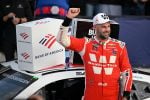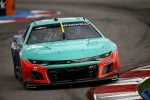The setting is 60 years ago in the small city of Owensboro, Ky.
It is a quiet, peaceful night. However, it is like the oppressive calm after a bloody battle. Only hours earlier, police sirens wailed, powerful car engines roared and tires screamed, shattering the serenity of the evening.
There had been a dangerous, yet magnificent, car chase, something out of “The Untouchables” or “Bullitt.” The car running from the law had blazed down city streets and alleys. It finally eluded its hunters and escaped into the countryside.
Townspeople had watched in awe, because the passengers in that elusive vehicle were mere boys – but with the nerves of veteran daredevils.
Now, in the gray hours before dawn, the car stealthily creeps back into the city. It is mangled, bullet-ridden and its engine is overheating. It has been through mud, gravel and cornfields.
It slips quietly into a small area behind a body shop, and its sputtering engine grows silent.
Slowly, the driver emerges. He cautiously looks all around. Convinced no one has seen him, he quickly and quietly whisks away.
His name is Darrell Waltrip. And he does not have a driver’s license.
That dramatic, yet true, scenario was created following an interview with Waltrip in 1982, a year after his first NASCAR Cup Series championship in his initial season driving for legendary team owner Junior Johnson.
In 1981, Waltrip won 12 races, 11 pole positions and earned 25 top-10 finishes to win the championship in what was easily the best season of his career.
Almost from the start of his career in 1973, Waltrip had been a competitor who seemingly had no problem speaking his mind – and, additionally, with no problem about what or whom to speak.
As you might imagine, he was a media delight. But to many fans and fellow competitors, he was hardly delightful. Fans thought him arrogant and disrespectful of the successful drivers who came before him.
Several competitors felt the same way. Before he hired him, Johnson had called him “mouthy,” and, as has been well recorded, Cale Yarborough, who won three titles with Johnson, gave Waltrip his infamous nickname, “Jaws.”
In 1982, as he sat in his hauler at EchoPark Speedway, formerly known as Atlanta Motor Speedway, Waltrip acknowledged his long-standing reputation as a “rabble rouser,” as he put it.
But it wasn’t part of him; rather, it was a byproduct of his career.
“I guess I was a shy kid,” he said. “I don’t really know. I felt like I got along with the other kids. I goofed around. I was a clown and cutup in class, but I think that’s sort of like an entertainer talking about his personality. He feels he’s shy and not outgoing. But he performs in front of people anyway.
“I believe it figures into your profession. It gives you confidence to do other things when you are successful at it. I used to get sick to my stomach when I had to make small speeches at breakfast meetings. For some time now, I’ve been able to get up in front of anyone and do what I have to do.”
Waltrip added that his boosted self-confidence helped him accomplish what he had in his racing career.
And, as history has recorded, he was to accomplish much more.
Contrary to what some have assumed over the years, Waltrip didn’t succeed because he had all the financial help he needed from friends and family.
He wasn’t pampered or provided. His father, Leroy, drove a Pepsi truck yet never stood in the way of his son’s ambition to be a race driver.
“I never got anything handed to me,” Waltrip said. “The only thing I remember was that my father encouraged me when I started racing go-karts. And my mother would do without things like a new dress because they were spending money on me.”
They might not have done so had they realized what their son had become when he got into his high school years.
It might be that the police of Waltrip’s hometown knew him by his first name. He was both a legend and a terror on the highways. He was utterly fearless in an automobile.
It evolved that Waltrip and his buddies took up drag racing on a strip of narrow, public highway outside of town. Their routine participation created crowds and noise – not to mention danger. And it was, of course, illegal.
The police broke up the sessions a few times and became determined to corral the leaders, specifically, Waltrip.
At the time, Waltrip had a hulking Oldsmobile known as “The Blue Goose.” In it, he would take on all comers.
Later, Waltrip drove a high-powered Chevelle. It was in this car that he and his buddies would undertake a decidedly dangerous enterprise.
Without any other challenges, they would lure cops to chase them by hurling beer bottles at their patrol cars.
On the night of the wild chase, Waltrip was the driver of a buddy’s car. He had lost his driver’s license after he was nabbed by police on the scene of one of the routine drag racing events.
He was caught before he ever fired the engine of his car. The police knew who he was and what he was up to. They charged him with “attempted drag racing,” of all things.
And, almost unbelievably, he was convicted.
“I was riding around town on a moped,” Waltrip said.
On the fateful night, it didn’t matter that Waltrip didn’t have a driver’s license. He and his friends decided it would be a good idea to get the cops to chase them again.
They lured one to pursue them – most likely by hurling beer bottles. Soon, that one became two, then three, then four.
Racing along roads, down alleys and into fields, Waltrip and his buddies never shook their pursuers.
Finally, they eluded the law by parking in the driveway of a country home. But as they began to steal away, a police vehicle pulled up, unaware they were there.
Seeing Waltrip and friends slinking away in the distance, the cop fired his pistol in an attempt to flatten their tires. Bullets shredded sheet metal but nothing else.
The chase was on again, and it didn’t end until Waltrip crept through a cornfield and back onto the highway a half-mile ahead of the police vehicle.
As morning approached, Waltrip nursed the battered car to its hiding place behind that body shop. He then snuck away.
The police found the car behind the body shop almost immediately. And they didn’t have to guess who had been in it.
Months later, Waltrip and his buddies were hauled into court, seemingly charged with everything but first-degree murder.
Because no one got a good look at the man behind the wheel, it was assumed it was the owner of the car, one of Waltrip’s buddies.
Waltrip’s lawyer told him that as long as his buddies didn’t rat on him, he was safe from prosecution – or at least he would not incur penalties as the ringleader.
When the first of Waltrip’s gang took the witness stand, he was asked by the prosecution if he knew what perjury was.
“It’s lying during testimony,” the lawyer said to the wide-eyed kid. “And you will go to jail for it.”
Almost immediately, the kid pointed to Waltrip and said, “He did it! He did it!”
The others joined in. All testified that it was Waltrip behind the wheel.
But something happened. The prosecuting attorney determined that all their testimony was conspired to direct all blame to one man.
“Even though my buddies turned chicken and said I was the driver, the prosecutor stood up and told the court it was obvious I was being railroaded,” Waltrip said. “The guy who owned the car was the driver and the culprit.”
As a result, Waltrip walked away from the trial unpunished.
He never returned to drag racing and the other misguided activities.
Well, as far as anyone knows, anyway.
Steve Waid has been in journalism since 1972, when he began his newspaper career at the Martinsville (Va.) Bulletin. He has spent over 40 years in motorsports journalism, first with the Roanoke Times-World News and later as publisher and vice president for NASCAR Scene and NASCAR Illustrated.
Steve has won numerous state sports writing awards and several more from the National Motorsports Press Association for his motorsports coverage, feature and column writing. For several years, Steve was a regular on “NASCAR This Morning” on FOX Sports Net and he is the co-author, with Tom Higgins, of the biography “Junior Johnson: Brave In Life.”
In January 2014, Steve was inducted into the NMPA Hall of Fame. And in 2019 he was presented the Squier-Hall Award by the NASCAR Hall of Fame for lifetime excellence in motorsports journalism. In addition to writing for Frontstretch, Steve is also the co-host of The Scene Vault Podcast.






